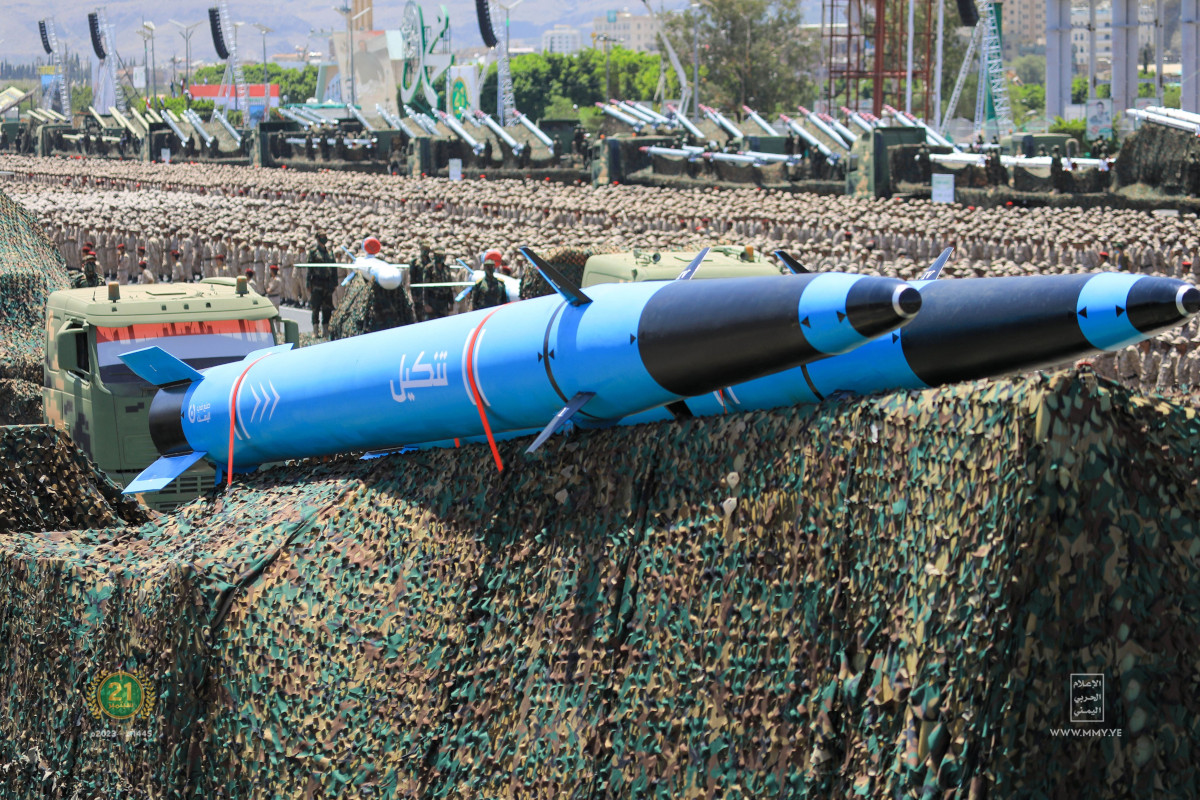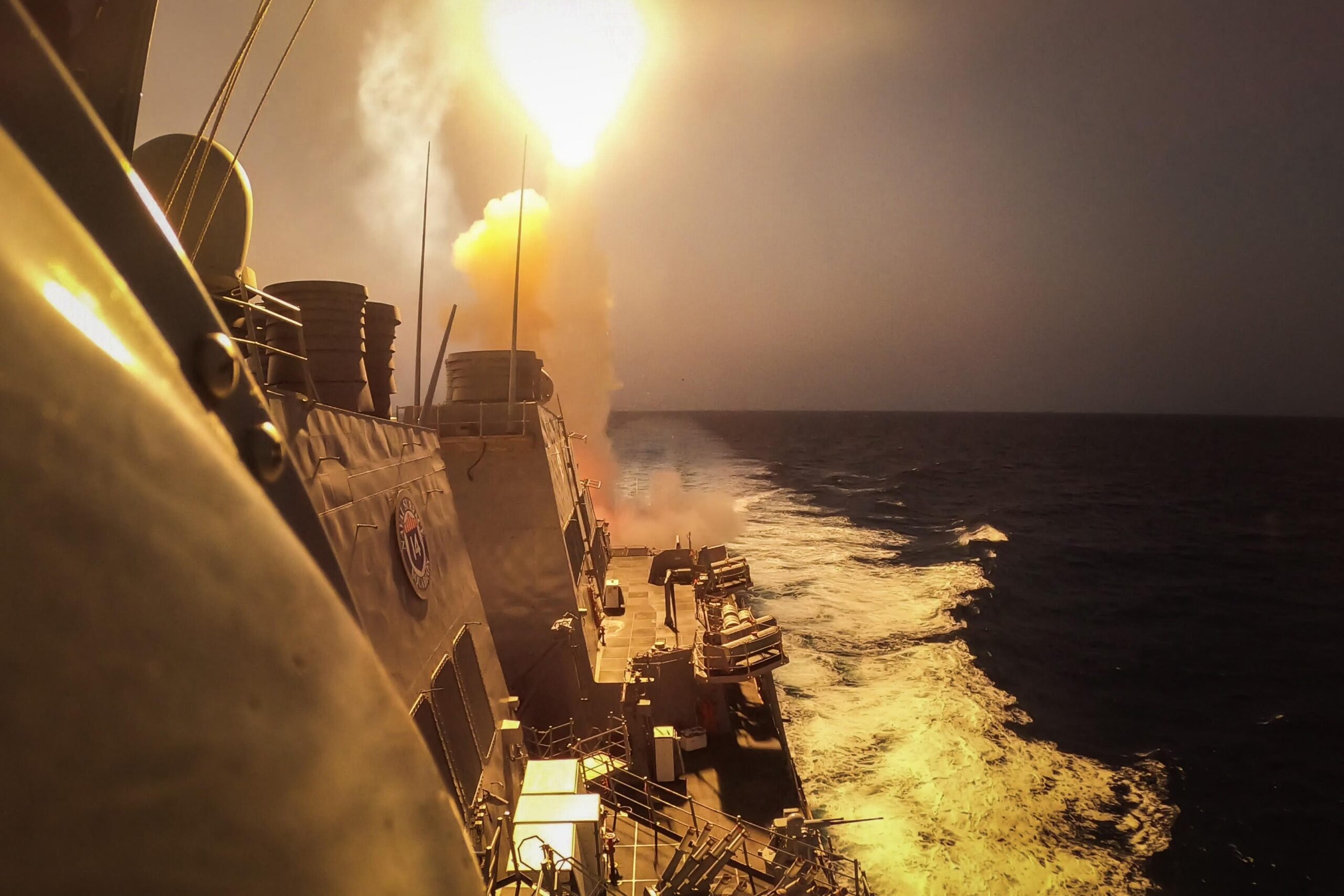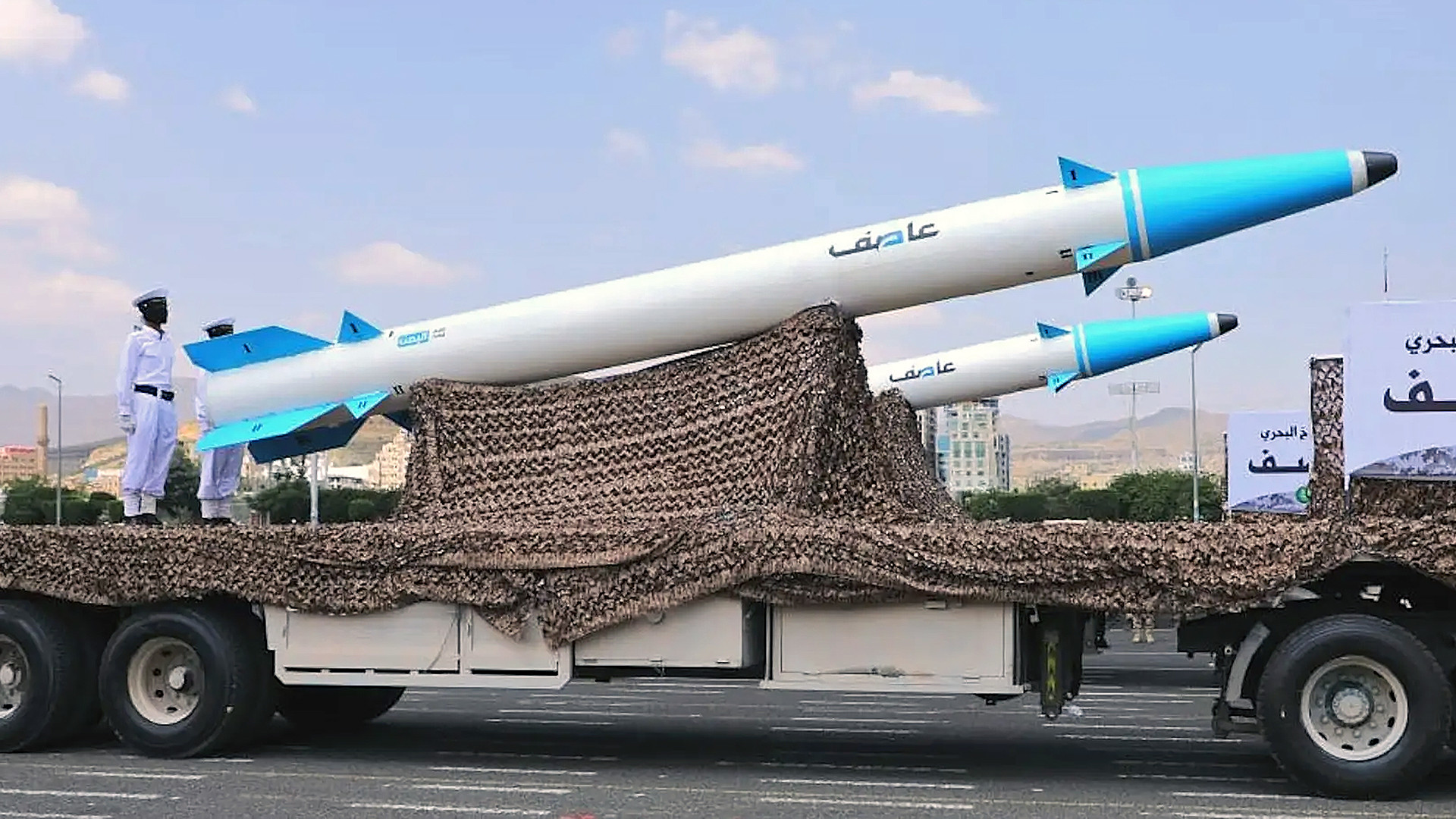Iranian-backed Houthi militants have become the first in the world to fire anti-ship ballistic missiles in anger, a threat that has been a hot topic of discussion for years. The group has also been making use of an increasingly diverse arsenal of anti-ship cruise missiles, and layering in kamikaze drones on top, in dozens of attacks in and around the Red Sea in the recent months. Despite all this, details about the Houthi anti-ship missile arsenal remain obscure, and recently the International Institute for Strategic Studies think tank put together a useful guide to these weapons.
The International Institute for Strategic Studies (IISS) first published its dive into the Houthi anti-ship missile arsenal last week. Details were provided about six anti-ship ballistic missiles and six more anti-ship cruise missiles that the Iranian-backed Yemeni group has acquired since 2014. A graphical breakdown of these weapons, seen below, was accompanied by an analysis of those capabilities from IISS’ Research Fellow for Defence and Military Analysis Fabian Hinz. That analysis is worth reading in full and can be found here.

It’s worth noting up front that the Houthis claim that the vast bulk of their overall missile arsenal, as well as their drones, are domestic developments, despite the undisputable involvement of the Iranian government in those efforts. How much actual development, production, and/or assembly of missiles or drones occurs locally in Yemen, with or without direct Iranian assistance, has long been unclear.
Independent assessments of the actual capabilities of any of these missiles are equally difficult to make. It is also not clear exactly which types have been used in attacks in and around the Red Sea since last October. However, the Houthis have used a variety of missiles and drones to good effect against targets on land and at sea in the past, and the threats that its arsenal poses are very real.
The Houthi anti-ship ballistic missile arsenal
The Houthis have publicly shown at least six different anti-ship ballistic missiles, all of which have unveiled large parades over the years. All of them look to have electro-optical/infrared seekers in their noses, which would be their primary mode of guidance in the terminal phase of flight.
The Asef (also sometimes written Asif) is an anti-ship derivative of Iran’s Fateh 313 short-range ballistic missile, which has a reported maximum range of nearly 280 miles (450 kilometers) and has an electro-optical/infrared seeker, according to IISS. Iran has itself previously shown an anti-ship version of the Fateh 110, from which the Fateh 313 was developed. The extended Fateh 110 family includes combat-proven designs. Variants and derivatives have been used against U.S. forces in Iraq and targets in Syria.


The Tankil appears to be a version of the Iranian Raad-500 short-range ballistic missile configured for anti-ship use. Tankil is smaller than Asef, but is assessed to have a longer range of around 310 miles (500 kilometers), per IISS.

Beyond Asef and Tankil, the Houthis have “three smaller ASBMs [anti-ship ballistic missiles] … strongly resemble Iranian design philosophy and seeker technology but do not precisely match known Iranian systems,” according to IISS. These are the Faleq, Mayun, and Al Bahr Al Ahmar. Al Bahr Al Ahmar is notably the Arabic name for the Red Sea.
Details about the three smallest Houthi anti-ship ballistic missiles are very limited. IISS says the range of the Faleq is just under 87 miles (140 kilometers). Other sources suggest this missile might be derived from the Iranian Fajr-4 guided artillery rocket, which has also been shown in air-launched configuration. Further information about the Mayun or Al Bahr Al Ahmar is even more scant.



Then there is the Muhit (also written variously as Mohit or Moheet), which is not derived from Iranian design, though that country very likely aided in its creation. Muhit is an anti-ship version of the Houthi Qaher-2 series of surface-to-surface missiles, which are in turn conversions of old Soviet SA-2 surface-to-air missiles.

The use of surface-to-air missiles, or derivatives thereof, in the surface-to-surface role, either in an improvised fashion or by design, is not limited to the Houthis. Many surface-to-air missiles, especially longer-range types, have inherent qualities that make them suitable for use against ground targets using ballistic trajectories. The Soviet S-300 surface-to-air missile system, variants of which remain in service in multiple countries around the world, has a little-known baked-in surface-to-surface capability, which Russian forces have been making use of in Ukraine. There are also reports that Ukrainian forces have been using Soviet-era S-200s as improvised ballistic missiles.
More specifically to the Houthi Muhit, China’s M-7 short-range ballistic missile was also an SA-2 derivative. The Iranian government reportedly acquired hundreds of those weapons shortly after the end of the Iran-Iraq War, dubbing them Tondar 69s. This would have given Iran experience with the general concept that could have then aided the Houthis in the repurposing of Yemeni SA-2.

Ballistic missiles, in general, come down on their targets at high speeds, which presents distinct additional challenges for defenders compared to air-breathing threats, like cruise missiles. That the Houthis have been employing anti-ship ballistic missiles together with anti-ship cruise missiles and drones in complex layered attacks only adds to these challenges.
At the same time, some of the Houthi anti-ship ballistic missiles are at the very low end of the capability spectrum, which would mean lower peak altitudes and speeds, and make them easier to intercept. This may have allowed the Navy to use SM-2 surface-to-air missile variants, with limited terminal ballistic missile intercept capability, instead of far more advanced and expensive SM-6s. These weapons likely fall well below the need to employ midcourse-intercept capable SM-3s.
The Houthi’s anti-ship cruise missile inventory
Though the Houthi’s use of anti-ship ballistic missiles is new, the group has been attacking ships with cruise missiles for years. The earliest anti-ship missiles the Iranian-backed militants are known to have acquired are stocks of Soviet-made P-21/P-22s (members of a series of missiles known to NATO as the SS-N-2 Styx) and C-801s from China. The P-21/P-22s are part of a larger shore-based coastal defense missile system called Rubezh and known in the West as the SSC-3 Styx.

The P-21/P-22 and C-801s are anti-ship cruise missiles with ranges of around 50 and 25 miles (80 and 40 kilometers), respectively. They both use active radar seekers to find their targets. The P-21/P-22s also have an infrared homing capability, which provides a valuable additional guidance option, especially in situations where there is heavy electronic warfare jamming.
The video below shows elements of a Vietnamese Rubezh/SSC-3 coastal defense missile system during training.

The armed forces of the internationally recognized government of Yemen had previously acquired the P-21/P-22s and C-801s (the latter of which the Houthis also call Al Mandab/Al Mandab 1). Stocks of these weapons then ended up in Houthi hands after the group seized control of the capital Sanaa and other areas of the country in 2014.

The P-21/P-22 and C-801 “missiles are still paraded by the Houthis, but it is unclear if they remain operational or how many they possess,” the IISS’s Hinz notes in his analysis. “More critically, though, the Houthi forces have gotten their hands on new, better equipment since those early acquisitions.”
The more capable anti-ship cruise missiles that the Houthis have since acquired include what the group calls the Al Mandab 2, which looks to be a copy of the Iranian Ghadir (or even examples of Ghadir supplied directly from Iran), according to IISS. Ghadir itself is an enlarged Iranian derivative of the radar-guided Chinese C-802, and has a purported range of 186 miles (300 kilometers).

There is also the possibility that the Houthis may have received earlier Iranian variants and derivatives of the C-802, including the Noor (a more or less direct clone of the Chinese missile) and the Ghader (which has a reported 124-mile/200-kilometer maximum range). Reports have suggested that the Houthis used Iranian C-802 variants or derivatives to destroy the high-speed logistics ship Swift, then in United Arab Emirates (UAE) service, near the Bab Al Mandeb Strait in 2016. The group also targeted multiple U.S. warships in that same general area, which is a strategically significant chokepoint between the Red Sea and the Gulf of Aden, that year.
That the Houthis inventory of what they call the Al Mandab 1/2 includes some combination of Noor/Ghader/Ghadir missiles is further supported by the U.S. military’s seizure of what were described as “components of the Iranian-manufactured C802 anti-ship cruise missile,” as well as other weapons and materiel, headed to Yemen in 2019.

More Iranian-designed anti-ship cruise missiles
The Houthi anti-ship cruise missile inventory now includes multiple types developed domestically by Iran. These include the Sayyad and Quds Z-0, both of which are variants or derivatives of the Quds series of land attack cruise missiles with apparent anti-ship capability and appear to have first emerged last year.


“One version is allegedly equipped with a radar-homing seeker (Sayyad), and the other has an electro-optical/infrared seeker (Quds Z-0),” the IISS’s Hinz wrote in his analysis. “Based on the range of the original Quds [design] and on Houthi statements, both systems could have a range of at least 800 km [nearly 500 miles].”
The Houthis claim the Quds Z-0 retains a land-attack capability, as well, Hinz told The War Zone directly.
The Houthis have already been actively employing successively more capable versions of the Quds family since 2019. Iran finally acknowledged being the source of the Quds design (which the U.S. government also refers to just as the “351” missile) when it publicly showed an identical cruise missile called Paveh during Russian Defense Minister Sergei Shoigu’s visit to the country in September 2023.
Last year, the Houthis also unveiled a smaller anti-ship cruise missile called the Sejil (also sometimes referred to as Sahil), details about which are very limited so far. There are unconfirmed reports that this weapon, also believed to be Iranian in origin, has a range of almost 112 miles (180 kilometers) and carries a 220-pound (100-kilogram) warhead, but how it is guided is unknown.

The full scope of Houthi anti-ship missile capabilities
Yemen’s Houthis have clearly amassed a very diverse and real arsenal of anti-ship missiles, and have also shown a willingness and capacity to employ them. The group’s use of the anti-ship ballistic missiles operationally in recent months is especially notable.
However, over the course of at least 26 separate incidents in and around the Red Sea since last October, Houthi strikes have not sunk a ship or resulted in a major casualty. The group has also launched at least 62 anti-ship missiles and drones in the course of those attacks, according to the U.S. Navy, but most of them have either been shot down or failed to hit anything.

All of this can only raise questions about the true scale and scope of the Houthis anti-ship capabilities, as well as how long the group may be able to keep up its current operational tempo.
One of the biggest questions is how the Houthis are targeting their anti-ship strikes, to begin with. When it comes to their missiles, radar and electro-optical/infrared seekers would give them the ability to zero in on targets in the terminal stages of flight, but there is still the need to cue them to a designated general area first.
“They [the Houthis] lack advanced intelligence, surveillance, and reconnaissance (ISR) tools, such as maritime patrol aircraft and satellites, which are usually associated with providing targeting information for long-range anti-ship systems,” the IISS’s Hinz wrote in his analysis. “Even so, they possess other ISR assets, including UAVs, nominally civilian vessels used for scouting, open-source information on maritime traffic, and data gathered by the Behshad, an Iranian cargo vessel anchored in the Red Sea reported to serve as an Islamic Revolutionary Guards Corps forward-operating and reconnaissance base. It also seems likely that Iran has equipped the group with coastal radar systems.”
It’s worth noting that online ship tracking software showed that Behshad made some unusual movements around the time of the Houthi missile and drone attacks just yesterday. The ship now appears to be heading back to Iran. Behshad quietly took the place of another similar IRGC mothership in the Red Sea, the Saviz, after the latter was damaged in an attack reportedly carried out by Israel in 2021.
“Stockpiles are another big unknown,” Hinz told The War Zone. “We simply do not know how many of the various types they have amassed. In general, one can say that the Iranians seem to have established pretty solid ways of transporting weaponry to Yemen, as proven by the use of Iranian-supplied missile systems against Saudi Arabia and the UAE in recent years.”
How deep the Houthis’ stockpiles of any of its different anti-ship missiles might be would be a factor in how long the group can keep up these strikes.
Speaking generally about the fact that many Houthi missiles seem to be missing their mark completely, Hinz also told The War Zone “that we simply do not know how mature these designs are and how often they have been tested (presumably in Iran proper).”
There is also the possibility that, at least in some instances, the Houthis may be deliberately missing. Missing on purpose could be a ploy to draw other ships, especially foreign warships, into riskier positions or be a way to conduct harassing attacks with less danger of retaliation. Regardless, the group has already succeeded in significantly disrupting commercial shipping through this highly strategic region.
Ramifications beyond the Red Sea
All this being said, the Red Sea now looks to have become a crucible for gleaning real-world data about Iranian anti-ship missiles and related capabilities. This could be a boon for Tehran and its various regional proxies, not just the Houthis.
“To me, a big part of this story is the Iranians getting very interested in optical and IIR [imaging infrared] seeker and guidance technology and it in an increasingly large variety of systems,” IISS’s Hinz told The War Zone. “These include surface-to-air missiles (358), one way attack munitions (some versions of the Shahed 238) as well as ballistic missiles for both land attack and anti-ship missions.”
The video below shows Iran’s Supreme Leader Ali Khamenei being shown various missile and drone developments in November 2023.

By the same token, the United States and others are getting a first-hand look at these threats. This is valuable information for the development of new and improved technical countermeasures and tactics, techniques, and procedures, all of which could be applicable well beyond the Red Sea.
Hinz pointed out that the Houthi’s missile strikes offer an interesting window into the potential broader impacts of the fielding of anti-ship ballistic missiles. Chinese efforts in this regard, which generally involve much larger and longer-range designs than the ones the Houthis have in their arsenal, have been a subject of great debate in recent years.
“When you are dealing with Yemen and the Red Sea or Iran and the Gulf, you are dealing with both very different systems and a vastly different context. … that has quite a few interesting implications,” he said.
Houthi attacks on the sea lanes in and around the Red Sea involving anti-ship missiles, as well as drones, show no signs of subsiding any time soon, So, more about the true extent of the group’s maritime strike capabilities (and by extension those of Iran) may now continue to emerge.
Contact the author: joe@thedrive.com
